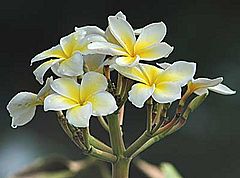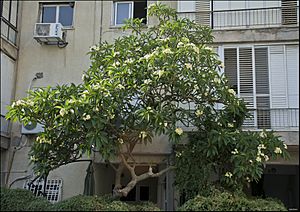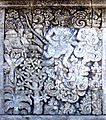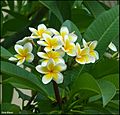Frangipani facts for kids
Quick facts for kids Plumeria |
|
|---|---|
 |
|
| Plumeria alba (White Frangipani) | |
| Scientific classification | |
| Kingdom: | |
| Division: | |
| Class: | |
| Order: | |
| Family: | |
| Genus: |
Plumeria
|
Plumeria (common name Frangipani) is a small genus of 7-8 species that grow in tropical and subtropical Americas. The genus consists of mainly deciduous shrubs and trees. P. rubra (Common Frangipani, Red Frangipani), that grows in Mexico, Central America, and Venezuela, produces flowers ranging from yellow to pink. From Mexico and Central America, Plumeria has spread to all tropical areas of the world, especially Hawaii, where it grows so abundantly that many people think that it is native there.
Contents
Description
Plumeria flowers are most fragrant at night in order to lure sphinx moths to pollinate them. The flowers yield no nectar, however, and simply trick their pollinators. The moths inadvertently pollinate them by transferring pollen from flower to flower in their fruitless search for nectar.
Plumeria species may be propagated easily by cutting leafless stem tips in spring. Cuttings are allowed to dry at the base before planting in well-drained soil. Cuttings are particularly susceptible to rot in moist soil.
There are more than 300 named varieties of Plumeria. American Plumeria society, Florida.
In culture
In Mesoamerica plumerias have carried complex symbolic significance for over 2000 years, with striking examples from the Maya and Aztec periods into the present.
These are now common naturalised plants in southern and southeastern Asia. In local folk beliefs they provide shelter to ghosts and demons. The scent of the plumeria has been associated with a vampire in Malay folklore, the pontianak; frangipani trees are often planted in cemeteries. They are associated with temples in both Hindu, Jain, and Buddhist cultures.
In several Pacific islands, such as Tahiti, Fiji, Samoa, Hawaii, New Zealand, Tonga, and the Cook Islands plumeria species are used for making leis. In modern Polynesian culture, the flower can be worn by women to indicate their relationship status—over the right ear if seeking a relationship, and over the left if taken.
Plumeria rubra is the national flower of Nicaragua, where it is known under the local name "sacuanjoche" and plumeria alba is the national flower of Laos, where it is known under the local name champa.
In some Bengali culture most white flowers, and, in particular, plumeria (Bengali, চম্পা chômpa or চাঁপা chãpa), are associated with funerals and death. In the Philippines and Indonesia, plumeria, which is known in Tagalog as Kalachuchi or Kalatsutsi (Plumeria acuminata), often is associated with ghosts and graveyards. Plumerias often are planted on cemetery grounds in both countries. They are also common ornamental plants in houses, parks, parking lots, etc. in the Philippines. Balinese Hindus use the flowers in their temple offerings.
In Malaysia, the plumeria's scent is known to be associated with the pontianak.
Indian incenses fragranced with plumeria rubra have "champa" in their names. For example, Nag Champa is an incense containing a fragrance combining plumeria and sandalwood. While plumeria is an ingredient in Indian champa incense, the extent of its use varies between family recipes. Most champa incenses also incorporate other tree resins, such as Halmaddi (Ailanthus triphysa) and benzoin resin, as well as other floral ingredients, including champaca (Magnolia champaca), geranium (Pelargonium graveolens), and vanilla (Vanilla planifolia) to produce a more intense, plumeria-like aroma.
In the dialect of Kannada spoken in the Old Mysore region of Karnataka of southern India, the flower is called Devaga Nagale. In the Western Ghats of Karnataka, the local people use cream colored plumeria in weddings. The groom and bride exchange plumeria garland at the wedding. It is alternatively called devaganagalu or devakanagalu (God's Plumeria). Red colored flowers are not used in weddings. Plumeria plants are found in most of the temples in these regions.
In Sri Lankan tradition, plumeria is associated with worship. One of the heavenly damsels in the frescoes of the fifth-century rock fortress Sigiriya holds a 5-petalled flower in her right hand that is indistinguishable from plumeria.
In Eastern Africa, frangipani are sometimes referred to in Swahili love poems.
Some species of plumeria have been studied for their potential medicinal value.
Images for kids
-
Plumeria relief in Penataran temple, Blitar, East Java
-
Red frangipani found in Malaysia.
-
White Plumeria, found at Andhra Pradesh
See also
 In Spanish: Plumeria para niños
In Spanish: Plumeria para niños
















